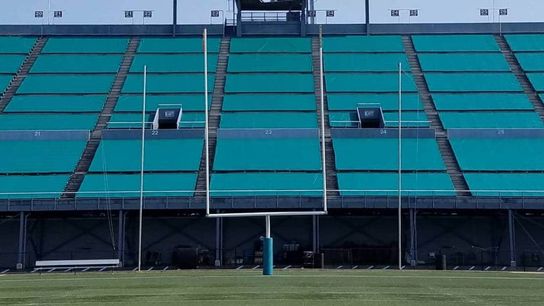As the NFL stares down the possibility of an empty-stadium season, the league has reportedly settled on a way to make up for lost ticket revenue.
According to a report Wednesday from Ben Fischer of Sports Business Journal, the NFL will tarp over the first 6-8 rows in each stadium to cover with advertisements.
This solves two obvious problems, reducing the buzzkill of empty seats while simultaneously recouping losses from unused tickets. An NFL sales executive said the plan will "significantly" aid the league in covering its Covid-19 budget hole. (The plan has yet to be approved by NFL owners, but we're talking about a group here that has never turned down a new dollar they didn't like.)
Of course, the NFL is not the first to adopt such a strategy.
There is another revenue stream opened by other sports leagues but as yet untapped by the NFL and college football: jersey advertising. The NBA generated $150 million in new revenue in its first two seasons of the trial program, and league executives believe that may prove to be the tip of the iceberg.
“Like most teams, we’re heading towards renewal thinking these are worth substantially more, because the impression numbers have been so good,” Milwaukee Bucks president Peter Feigin told SBJin 2019. In 2017, the Spanish soccer club Real Madrid struck a deal with Fly Emarites for 70 million euros ($79.1 million) per year for five seasons.
While it's unlikely the NFL would realize those dollars -- Real Madrid's deal is the highest on record -- any sort of on-field advertising figures to be especially valuable this season, as network producers prep for a season full of tight shots to obscure a potentially empty stadium.
It's difficult to suss out exactly how much NFL clubs will lose from unsold seats closest to the field. Let's assume the typical NFL team drapes over its closest 5,000 seats, and those usually go for roughly 250 bucks a pop. That's $1.25 million. Now, that is assuredly a low-ball guesstimate. Plenty of teams have more than 5,000 seats among their first 6-to-8 rows encircling the field, plenty charge more than an average $250 face value, and a number of teams sell on-field suites, which will also be tarped over under this plan.
So let's double our low-ball estimate. No, let's triple it, quadruple it, decuple it. (That means multiply by 10.) Even then you get $12.5 million per team per home game.
That's a healthy chunk of change, but not an insurmountable one.
Think about it: There is no television property more valuable than an NFL game. That's true in any year, and figures to be even more true this year, as our country is starved for normalcy and strongly encouraged (if not outright required) to stay home as much as possible.
It's pretty easy to squint and see the NFL making $12.5, $15, $20 million per game in field-adjacent advertising that wasn't available to them previously.
The coronavirus and its fallout have created two types of changes. The first is those where companies used the coronavirus as political cover to do a thing it was planning on doing anyway. Think of an athletics department cutting a non-revenue sport or a major corporation announcing mass layoffs.
The second type of change is one that was initially announced as temporary, only the Powers That Be discovered to be a positive change, and thus quickly became permanent.
As football becomes a game more and more catered to the at-home viewer as opposed to the in-person one, isn't it easy to see these tarps sticking around for 2021 and beyond?
